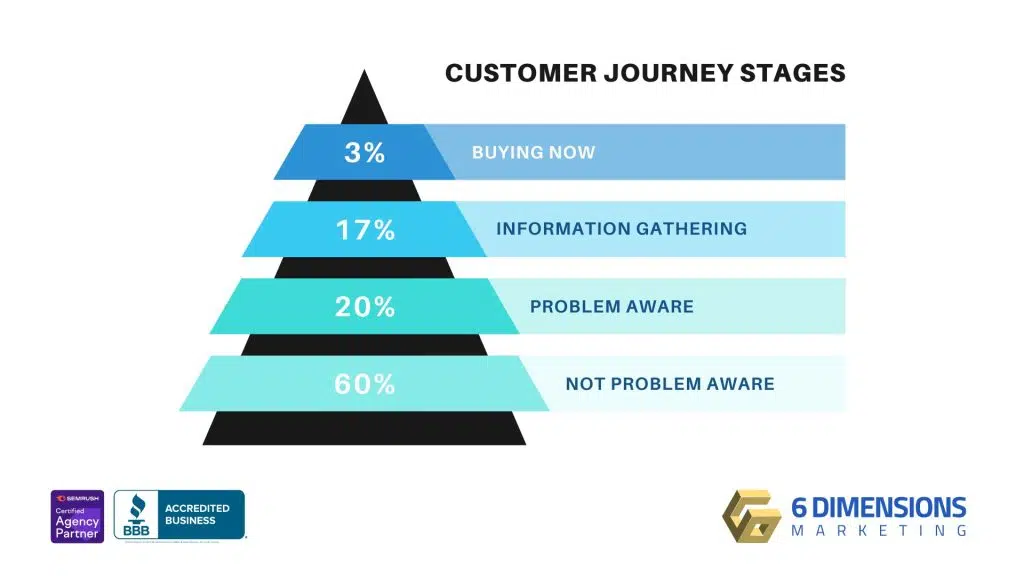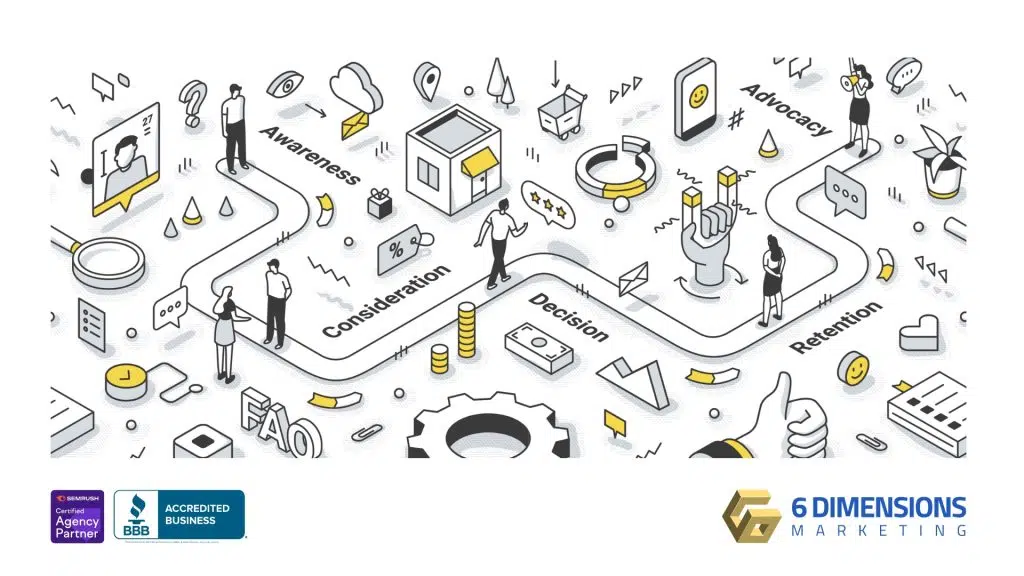Introduction
In today’s hyper-competitive market, understanding and navigating the customer journey isn’t just a strategy—it’s a necessity. With the digital world providing consumers with an abundance of choices, businesses that master the art of guiding their prospects through a carefully curated path find themselves at a distinct advantage. This journey, which seamlessly transitions potential customers from mere awareness to making informed decisions and ultimately purchasing, is paramount to achieving sustained business growth.
At the heart of this journey are three pivotal stages. First, there’s the Problem Awareness stage, where prospects first recognize a challenge or need they are facing. It’s that initial “I think I have a problem” moment, and it’s the perfect time for businesses to step in, acknowledge that issue, and hint at a potential solution. Next, as prospects move into the Information Gathering stage, they begin to actively seek out solutions, diving deep into research, reading reviews, and comparing options. This stage is all about providing value, information, and building trust. Finally, the Purchase Decision stage arrives when prospects are on the cusp of making a choice. Now, they’re weighing the pros and cons, considering the implications of their decision, and looking for that final push to take action.
Throughout this article, we will delve into the intricacies of each of these stages, offering insights and strategies to help businesses effectively navigate this journey, ensuring not just a sale, but a satisfied and loyal customer.
Understanding the Customer Journey Funnel
The customer journey funnel is an instrumental concept in modern marketing. At its core, it visualizes the path a prospect takes, from the moment they first become aware of a problem or a need, through to the final act of making a purchase and even beyond, into post-purchase behaviors.
This funnel isn’t just a theoretical construct—it’s a roadmap for businesses. By understanding the distinct phases within the funnel, marketers can tailor their messages, strategies, and interactions to fit the specific mindset and needs of prospects at each stage. This ensures that potential customers feel understood, valued, and guided as they naturally progress from one phase to another.
If you’re new to this concept or seeking a deep dive into its intricacies, I highly recommend our previous article, “Unlocking the Secrets of the Customer Journey in Marketing Strategy“. It offers a comprehensive look into the strategic underpinnings of the customer journey and its integral role in shaping successful marketing campaigns.
Nevertheless, as we progress in this article, always bear in mind the overarching importance of the customer journey funnel: It’s not just about making a sale; it’s about crafting a meaningful and guided experience for each potential customer, ensuring they feel engaged, informed, and valued every step of the way.

Problem Awareness Stage
The initial flicker of recognition in a prospect’s mind that there might be an issue needing resolution marks the beginning of their journey. This is the Problem Awareness Stage—a crucial moment when potential customers first identify a challenge, discomfort, or unmet need in their lives.
During this phase, the prospect is only just beginning to grasp the contours of the problem. They may not yet be searching for solutions, but they have a budding awareness that something isn’t quite right. For businesses, this is a golden opportunity to position themselves as understanding allies, capable of not just recognizing the problem, but also offering a way forward.
Now, you might be asking: How does a business effectively communicate with prospects at this nascent stage? How do you shift a potential customer from being completely unaware of an issue to acknowledging and confronting it? For a detailed exploration on this, do dive into our previous article titled “Effective Messaging for Shifting Prospects from Unaware to Problem Aware Stage“. It provides invaluable insights into crafting messages that resonate and ignite that initial spark of awareness.
However, as we delve deeper into the Problem Awareness Stage in this article, remember that the goal is not to rush a sale, but rather to nurture a connection. It’s about empathizing with the prospect’s budding realization, offering them insights, and setting the stage for a journey of discovery that ideally leads them right to your solution.
Effective Communication Strategies for the Problem Awareness Stage
- Tailored Content:
- Purpose: Your content should be specifically crafted to resonate with individuals at the early stages of their problem recognition.
- Implementation: Use relatable scenarios or stories that mirror the experiences or feelings of your target audience. This could take the form of blog posts, social media stories, or short video clips that highlight common challenges faced by your audience, subtly nudging them towards the realization that they face the same issues.
- Addressing Pain Points and Needs:
- Purpose: At this juncture, it’s essential to echo the prospect’s internal dialogues, making them feel seen and understood.
- Implementation: Utilize customer testimonials, case studies, or data-driven insights to showcase familiar pain points. It’s not about introducing your solution just yet; it’s about amplifying the problem in a relatable way, allowing prospects to see themselves in others’ stories and understand that they are not alone.
Transition Tactics to the Next Stage
As prospects begin to recognize their challenges more clearly, it’s time to subtly guide them towards the next phase: Information Gathering.
- Engaging CTAs (Calls-to-Action):
- Purpose: While your prospect is coming to terms with their problem, you should offer them a clear, inviting pathway to start seeking solutions.
- Implementation: Design CTAs that are inviting and not overly salesy. Phrases like “Learn More,” “Discover Why,” or “Find Out What Others Did” can be effective. The idea is to encourage exploration rather than pushing for an immediate decision.
- Educative Teasers and Snippets:
- Purpose: Give a sneak peek into the depth of information and solutions you offer without overwhelming the prospect.
- Implementation: Share short, digestible pieces of content—like infographics, factoids, or quick tips—that hint at broader topics. These should be designed to pique curiosity and make the prospect want to delve deeper into the subject, guiding them naturally to the Information Gathering stage.
Remember, the Problem Awareness Stage is all about gentle guidance, not a hard push. It’s a delicate dance of empathy, recognition, and subtle nudges towards deeper exploration, setting the stage for the relationship’s next, more in-depth chapter.
Information Gathering Stage: Navigating the Heart of Decision Making
Once prospects have acknowledged their problem or need, they naturally transition into the quest for answers. This pivotal phase is the Information Gathering Stage. Here, prospects actively seek solutions, sifting through available information, and gradually forming an opinion on the best way forward.
- Definition and Characteristics
What are prospects looking for?
- At this stage, prospects desire clarity. They’re looking for comprehensive information about potential solutions to their identified problem. This might include details about products, services, methodologies, or approaches that can address their needs.
Role of research and comparison in this stage:
- Research is the cornerstone of the Information Gathering Stage. Prospects delve into multiple sources, from official product websites to third-party review sites, to gather data.
- Comparison plays a pivotal role as well. Armed with their newfound knowledge, prospects juxtapose different solutions, weighing their merits and drawbacks, aiming to shortlist the most viable options.
- Content Strategies to Engage and Educate
Blogs, eBooks, and webinars:
- Blogs: Regularly updated and informative blog posts can offer insights, answer common queries, and position your brand as a thought leader in the field.
- eBooks: These dive deeper into topics, offering comprehensive guides or insights that a prospect can refer to at their own pace.
- Webinars: Interactive and often led by industry experts, webinars allow for real-time Q&A, making them a dynamic tool for both education and engagement.
Product comparisons and case studies:
- Product Comparisons: By presenting an unbiased comparison (even if it includes competitors), you not only provide valuable information but also showcase confidence in the merits of your offering.
- Case Studies: Real-world examples of how your product or service has resolved issues similar to what your prospect faces can be incredibly persuasive. It offers a tangible narrative of success.
- Encouraging Prospects to the Purchase Decision Stage
Trust-building tactics (reviews, testimonials):
- Reviews: Positive feedback from past users or clients can significantly sway a prospect’s opinion. Ensure that these are genuine and easily accessible.
- Testimonials: Detailed accounts or endorsements, especially from recognizable names or brands in the industry, can provide significant social proof and credibility.
Offering incentives or limited-time promotions:
- Purpose: To nudge prospects closer to making a purchase decision.
- Implementation: Offer limited-time discounts, exclusive bundles, or added bonuses (like free consultations or additional resources) to incentivize prospects to move from contemplation to action.
The Information Gathering Stage is a delicate balance of providing valuable information and gently leading prospects towards a decision. By understanding their mindset, offering the right resources, and building trust, businesses can effectively guide prospects closer to choosing their solution.

Purchase Decision Stage: Turning Prospects into Customers
Arriving at the Purchase Decision Stage is a culmination of a prospect’s journey through awareness and exploration. It’s the climax, where contemplation meets action, and prospects are on the cusp of becoming customers. Understanding the nuances of this stage is crucial for businesses aiming to convert interest into sales.
- Definition and Characteristics
The final push: What prospects need to make a purchase
- At this juncture, prospects have amassed a wealth of information and have likely narrowed down their options. Now, they’re looking for that final assurance or incentive that will compel them to commit.
Emotional vs. Logical Buying Triggers:
- Emotional Triggers: These are tied to feelings and instincts. A prospect might buy because a product makes them feel confident, secure, or part of a community.
- Logical Triggers: These are grounded in rationale and practicality, such as the product’s functionality, cost-effectiveness, or durability.
- Sales and Marketing Tactics to Seal the Deal
Clear and easy checkout process:
- Reduce friction during the purchasing process. Ensure that the checkout is intuitive, quick, and secure. Any hiccups here can lead to cart abandonment.
Addressing last-minute objections or concerns:
- Provide easily accessible FAQs, live chat support, or customer service contacts. Quick, clear answers at this stage can alleviate concerns and facilitate the purchase.
Offering guarantees or return policies:
- By offering risk-reducing measures like money-back guarantees or hassle-free returns, businesses can assuage fears of commitment and increase the likelihood of a sale.
- Post-purchase Considerations
Importance of after-sales service:
- Excellent post-purchase support can enhance customer satisfaction and reduce potential buyer’s remorse. Whether it’s offering setup assistance, usage tips, or addressing concerns, this service can make all the difference.
Encouraging repeat business and loyalty:
- The journey doesn’t end with a purchase. Engaging customers through loyalty programs, exclusive offers, or feedback surveys can foster long-term relationships. By ensuring they feel valued even after the sale, businesses can pave the way for repeat business and referrals.
The Purchase Decision Stage is not just about closing a sale; it’s about initiating a lasting relationship. By focusing on the needs and concerns of prospects at this pivotal point and extending care beyond the purchase, businesses can not only win customers but also advocates for their brand.
Tips for Seamless Transition Between Stages
The customer journey is a continuous flow, not a set of isolated incidents. Ensuring that prospects move effortlessly from one stage to the next not only enhances their experience but also increases the likelihood of conversion. Let’s delve into strategies that facilitate this seamless transition:
- Integrating Analytics and Tracking Tools
Why It’s Important:
- Data-driven insights provide a clear picture of where your prospects are within the funnel, helping identify areas of drop-off and points of engagement.
How to Implement:
- Use Comprehensive Tools: Platforms like Google Analytics, HubSpot, or Mixpanel can track customer behaviors, page views, and conversions.
- Analyze the Funnel: Regularly review the funnel analytics to identify bottlenecks or stages where prospects might be getting stuck. Adjust strategies accordingly.
- Set Up Alerts: Automated alerts for significant drop-offs or behavior changes can help you react in real-time.
- Personalizing the Experience Based on Customer Behavior
Why It’s Important:
- Every customer is unique. By tailoring the experience to individual behaviors, preferences, and history, businesses can make the journey feel more personal and relevant.
How to Implement:
- Segmentation: Use data to segment your audience based on behaviors, past interactions, or preferences. This allows for more targeted communications.
- Dynamic Content: Tools that offer dynamic content can adjust what a user sees on a webpage based on their past behavior, ensuring relevance.
- Retargeting Campaigns: These are ads specifically shown to individuals based on their past interactions with your brand, serving as gentle reminders or offers to encourage progression through the funnel.
- Maintaining Consistent Brand Messaging Across Stages
Why It’s Important:
- Consistency fosters trust. Prospects and customers should feel they’re interacting with a unified entity, regardless of where they are in the journey.
How to Implement:
- Unified Brand Guidelines: Ensure that all teams—whether they handle early-stage content or post-purchase customer service—are aligned in terms of brand voice, aesthetics, and values.
- Regular Training: Periodic training sessions can ensure that all employees are on the same page when it comes to brand messaging.
- Feedback Loops: Encourage teams to communicate regularly, sharing insights and feedback. This continuous loop ensures that the messaging remains consistent and adjusts in real-time based on customer interactions.
Transitioning between stages is an art, rooted in understanding and fueled by data. By keeping the customer at the heart of the strategy and ensuring that every touchpoint is crafted with care and consistency, businesses can offer a fluid, engaging, and fruitful journey for every prospect.

Common Pitfalls in the Customer Journey and How to Avoid Them
Understanding and optimizing the customer journey is paramount for businesses, but the road is often strewn with challenges. Here are some common pitfalls brands encounter and actionable strategies to sidestep them:
- Ignoring or Misinterpreting Signals from Prospects
The Pitfall:
Customers often send out cues through their behavior, feedback, or interaction patterns. Ignoring these signals or misinterpreting them can lead to missed opportunities or misguided strategies.
How to Avoid:
- Active Listening: Whether it’s feedback on social media, comments on blogs, or direct customer queries—ensure you’re actively monitoring and responding.
- Invest in Analytics: Utilize advanced tracking tools that can capture and analyze customer interactions on your platforms.
- Regular Surveys: Periodically gather direct feedback to understand pain points, needs, or areas of improvement.
- Offering Too Much Too Soon or Too Little Too Late
The Pitfall:
Pushing a sale aggressively when a prospect is still in the awareness or information stage can deter them. Conversely, offering value or incentives after they’ve lost interest can be futile.
How to Avoid:
- Segmented Marketing: Categorize prospects based on their journey stage and tailor communication accordingly.
- Trigger-Based Campaigns: Use behavior triggers to automate communication. For instance, a prospect who has viewed a product multiple times might receive a discount offer, nudging them to purchase.
- Maintain Balance: Avoid inundating prospects with information or offers. Instead, focus on timing and relevance.
- Not Adapting to Changing Customer Needs and Behaviors
The Pitfall:
What worked a year ago might not resonate now. Sticking to old strategies without adapting to the evolving landscape can render efforts ineffective.
How to Avoid:
- Stay Updated with Trends: Regularly research market trends, competitor strategies, and emerging technologies or platforms.
- Iterative Testing: Adopt a culture of A/B testing for campaigns, web pages, and communication strategies to ascertain what resonates best with your current audience.
- Feedback Mechanisms: Ensure mechanisms are in place for customers to share their evolving needs or preferences. This can be through feedback forms, regular surveys, or community forums.
Anticipating and sidestepping these pitfalls requires a blend of proactive strategy, reactive adaptability, and a genuine commitment to understanding and serving the customer. By maintaining this triad, businesses can foster a dynamic and effective customer journey.
Conclusion: Charting the Path to Success
The journey a prospect takes from the first spark of awareness to the final act of purchase is both intricate and essential. At every stage—be it the initial realization of a problem, the quest for solutions, or the crucial decision to commit—there’s an opportunity for businesses to guide, influence, and build a lasting relationship.
It’s not just about securing a sale; it’s about understanding needs, addressing concerns, and fostering trust. Each interaction, no matter how minute, contributes to the overarching narrative of a brand’s relationship with its customers.
However, as we’ve seen, this journey is rife with potential pitfalls. From misinterpreting signals to not adapting swiftly to changing needs, businesses can sometimes falter. Yet, the path forward is not set in stone. By regularly revisiting and refining strategies, businesses can stay attuned to their customers’ evolving desires and challenges.
In conclusion, guiding prospects through their journey is both an art and a science. It demands a delicate balance of data-driven insights and genuine human connection. For businesses dedicated to getting it right, the rewards are not just in revenue but in building a community of loyal and engaged customers.




